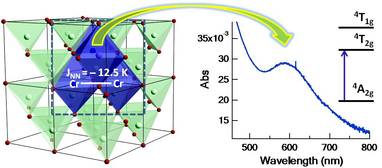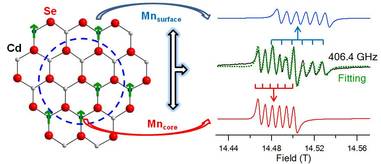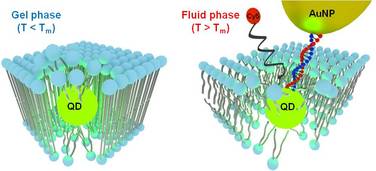Optical, electric, and magnetic properties of doped nanocrystals
 Semiconductor nanocrystals (NCs) with size-, shape-, and composition-tunable band gaps and luminescence are one of the most interesting materials capturing the interest of researchers over the past decades, and have broad applications in biological imaging, light-emitting devices, solar cells, photo-detectors, and quantum computing. Systematically incorporating paramagnetic ions onto the metal lattice sites for NCs represents an exciting area for generating a new class of dilute magnetic semiconductor NCs. We are working on the synthesis and characterization of low-dimensional NCs and doped NCs with novel optical, electric, and magnetic properties.
Semiconductor nanocrystals (NCs) with size-, shape-, and composition-tunable band gaps and luminescence are one of the most interesting materials capturing the interest of researchers over the past decades, and have broad applications in biological imaging, light-emitting devices, solar cells, photo-detectors, and quantum computing. Systematically incorporating paramagnetic ions onto the metal lattice sites for NCs represents an exciting area for generating a new class of dilute magnetic semiconductor NCs. We are working on the synthesis and characterization of low-dimensional NCs and doped NCs with novel optical, electric, and magnetic properties.
For doped NCs, it is possible to tune the band parameters and interactions by adjusting the host lattice composition, guest ions, and NC size and shape. In II-VI group metal chalcogenide and perovskite NCs, intentionally doping paramagnetic ions into the lattice core is difficult because of the high surface energies required for ion addition and self-annealing. To address this issue, we developed synthetic methodology (single-source cluster and pressure-mediated solvothermal methods) and synthesized a variety of doped NCs. We discovered that small CdSe quantum dots (QDs) doped with Mn(II) ions have unique super-paramagnetic (SPM) properties. By studying the size-dependent magnetic properties of Mn:CdSe QDs, we were surprised to find the magnetic behavior was influenced by carriers on the nanocrystal surface, which can mediate Mn(II)-Mn(II) ferromagnetic interactions. These observations demonstrated a powerful strategy to control magnetic properties by tuning the QD size. In the studies on Cr doped NCs, we discovered a low-temperature phase transition for CdSe QDs, and uncommon spinel inclusions in the core of the cubic ZnSe QDs. Incorporating spinel into QDs offers new opportunities for engineering unique crystal phases in nano-materials.
Characterization of the microenvironments within NCs
 Studying the surface and interfaces of NCs is a challenge due to the heterogeneous nanoscale structure of these materials. We developed a novel characterization method to elucidate critical details of the nature of the surface and interfacial micro-environments of NCs by using high-frequency electron paramagnetic resonance (EPR). We showed that Mn(II) ions incorporated into NCs can act as an active EPR probe. The microenvironments of the surface and core of CdSe QDs were successfully detected by hyperfine splitting from Mn ions. High-frequency EPR spectra of Mn(II) in CdSe/ZnS tetrapods provided clear evidence of hetero-alloying at the core-arm interface, in addition to the formation of intrinsic dislocations at grain boundaries, showing that short-range ion migration at the hetero-epitaxial layer reduces strain energy caused by the 12% lattice mismatch between CdSe and ZnS.
Studying the surface and interfaces of NCs is a challenge due to the heterogeneous nanoscale structure of these materials. We developed a novel characterization method to elucidate critical details of the nature of the surface and interfacial micro-environments of NCs by using high-frequency electron paramagnetic resonance (EPR). We showed that Mn(II) ions incorporated into NCs can act as an active EPR probe. The microenvironments of the surface and core of CdSe QDs were successfully detected by hyperfine splitting from Mn ions. High-frequency EPR spectra of Mn(II) in CdSe/ZnS tetrapods provided clear evidence of hetero-alloying at the core-arm interface, in addition to the formation of intrinsic dislocations at grain boundaries, showing that short-range ion migration at the hetero-epitaxial layer reduces strain energy caused by the 12% lattice mismatch between CdSe and ZnS.
Interface of inorganic nanoparticles and bio-molecules
 Lipid vesicle encapsulation is an efficient approach to transfer hydrophobic QDs into aqueous solutions. To better understand the molecular organization at the interface between a QD and lipid membrane of quantum dot-phospholipid membrane hybrid materials, we investigated the properties of 3.0 nm CdSe QDs encapsulated within phospholipid membranes displaying a range of phase transition temperatures (Tm). Using photoluminescence, ICP-MS, FT-IR, optical microscopy, and ligand exchange studies, we found that the Tm of the membrane controls QD photostability and ligand accessibility. Importantly, QDs encapsulated within gel-phase membranes were ultra-stable, providing the most photostable non-core/shell QDs in aqueous solution reported to date. Atomistic molecular dynamics simulations support these observations and indicate that membranes are disordered near the particle surface. Using membrane disorder, we site-specifically functionalized the QD surface facing the outer lipid leaflet to generate gold NP-QD assemblies programmed by Watson-Crick base-pairing. This study indicates that lipid membranes can control the chemical and optical properties of QDs in a phase-dependent manner.
Lipid vesicle encapsulation is an efficient approach to transfer hydrophobic QDs into aqueous solutions. To better understand the molecular organization at the interface between a QD and lipid membrane of quantum dot-phospholipid membrane hybrid materials, we investigated the properties of 3.0 nm CdSe QDs encapsulated within phospholipid membranes displaying a range of phase transition temperatures (Tm). Using photoluminescence, ICP-MS, FT-IR, optical microscopy, and ligand exchange studies, we found that the Tm of the membrane controls QD photostability and ligand accessibility. Importantly, QDs encapsulated within gel-phase membranes were ultra-stable, providing the most photostable non-core/shell QDs in aqueous solution reported to date. Atomistic molecular dynamics simulations support these observations and indicate that membranes are disordered near the particle surface. Using membrane disorder, we site-specifically functionalized the QD surface facing the outer lipid leaflet to generate gold NP-QD assemblies programmed by Watson-Crick base-pairing. This study indicates that lipid membranes can control the chemical and optical properties of QDs in a phase-dependent manner.
